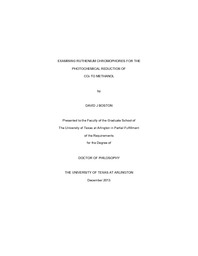
ATTENTION: The works hosted here are being migrated to a new repository that will consolidate resources, improve discoverability, and better show UTA's research impact on the global community. We will update authors as the migration progresses. Please see MavMatrix for more information.
Show simple item record
| dc.contributor.author | Boston, David J. | en_US |
| dc.date.accessioned | 2014-03-12T23:52:10Z | |
| dc.date.available | 2014-03-12T23:52:10Z | |
| dc.date.issued | 2014-03-12 | |
| dc.date.submitted | January 2013 | en_US |
| dc.identifier.other | DISS-12523 | en_US |
| dc.identifier.uri | http://hdl.handle.net/10106/24149 | |
| dc.description.abstract | Our consumption of energy for transportation and electricity has been growing as quickly as our population. As this demand for energy increases we increase our production of carbon dioxide by the burning of fossil fuels to try and meet this increasing demand. A sustainable method to convert carbon dioxide (CO₂) to a viable liquid fuel is one potential way in which both the increasing energy demand and increasing CO₂ concentration issues can both be helped. Currently such methods being investigated include thermal, electrochemical, and photochemical processes. Because thermal conversion is not an ideal situation because of the requirement of strong reducing agents or extreme conditions such as steam reformation reactions, we need to find better alternatives such as electrochemical and photochemical methods. Both electrochemical and photochemical methods have the ability to be sustainable, however, the vast majority of these systems are limited to producing CO and/or formic acid, with only a few performing deeper reduction to products such formaldehyde, methanol and methane. All of the systems capable of reducing CO₂ past two electrons involve either a heterogeneous catalyst (e.g. TiO₂) or an electrode. In recent times Bocarsly and coworkers have shown that pyridine was capable of reducing CO₂ to methanol through a sequential process of proton and electron transfers. This process seems to start with the formation of a CO₂-pyridine adduct in solution that is reduced one more time to form formate/formic acid. The next reduction is a slow process and allows for a buildup of formate in solution leading to a higher formate concentration in solution. The subsequent reductions seem to occur very rapidly and form methanol at good efficiencies. Theoretical work done recently has argued for the necessity of the Pt, Pd, or GaP surface in the electrochemistry. Carter and coworkers have claimed that the surface of the electrode is a necessary part of the catalysis with the pyridinium being only a cocatalyst for the reduction of CO₂. However, Musgrave and coworkers predict that the homogeneous reductions can take place with the aid of water molecules in solution. They allow for a PCET process to take place between the CO₂ and the pyridinium radical. This would allow for a second pathway for the catalytic reduction of CO₂ to methanol. Work done during this dissertation has shown that the photochemical reduction of carbon dioxide to methanol is possible using pyridine in a similar manner to Bocarsly and coworkers in their electrochemical system. By replacing the electrode with Ru(phen)₃Cl₂ it is still possible to drive the reaction using excited states of the chromophore to provide the electrons with enough energy to reduce the pyridinium to the radical species. This system has been shown to produce up to 66 uM methanol after 6 hours of irradiation of 470 nm light. Production of formate is also observed, with ~27 mM being observed within the first hour of irradiation. This system was further investigated with the incorporation of the pyridine catalyst into a chromophore system using the complex [Ru(phen)₂dppz](PF6)₂, [Ru(phen)₂pbtpα](PF6)₂, and [Ru(phen)₂pbtpβ](PF6)₂. Cyclic voltammetry experiments for these complexes show similar reduction potentials for with ~100 mV difference between them with [Ru(phen)₂dppz](PF6)₂ being the most negative and [Ru(phen)₂pbtpβ](PF6)₂ being the most positive. When the electrolyte solution was saturated with CO₂ only [Ru(phen)₂pbtpα](PF6)₂ and [Ru(phen)₂pbtpβ](PF6)₂ showed a response signifying catalysis was taking place. Initial photochemical tests with these complexes showed that [Ru(phen)₂pbtpα](PF6)₂ seemed to undergo dimer formation in the absence of CO₂ with [Ru(phen)₂pbtpβ](PF6)₂ forming a singly reduced species that is oxidized upon introduction of additional CO₂. Electrolysis of [Ru(phen)₂pbtpβ](PF6)₂ produces ~900 uM methanol with both CO and formate being produced as well. Photolysis of [Ru(phen)₂pbtpβ](PF6)₂ in DMF with 1 M H₂O and 0.1M TEA, no CO formation observed, however, both methanol and formic acid were observed after 1 hours of irradiation with methanol reaching 45 uM, 285 uM formaldehyde and 650 uM formate. | en_US |
| dc.description.sponsorship | MacDonnell, Frederick M. | en_US |
| dc.language.iso | en | en_US |
| dc.publisher | Chemistry & Biochemistry | en_US |
| dc.title | Examining Ruthenium Chromophores For The Photochemical Reduction Of CO₂To Methanol | en_US |
| dc.type | Ph.D. | en_US |
| dc.contributor.committeeChair | MacDonnell, Frederick M. | en_US |
| dc.degree.department | Chemistry & Biochemistry | en_US |
| dc.degree.discipline | Chemistry & Biochemistry | en_US |
| dc.degree.grantor | University of Texas at Arlington | en_US |
| dc.degree.level | doctoral | en_US |
| dc.degree.name | Ph.D. | en_US |
Files in this item
- Name:
- Boston_uta_2502D_12523.pdf
- Size:
- 1.335Mb
- Format:
- PDF
This item appears in the following Collection(s)
Show simple item record


